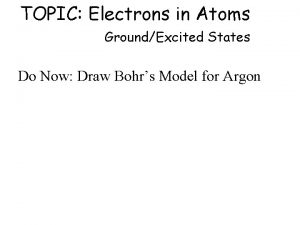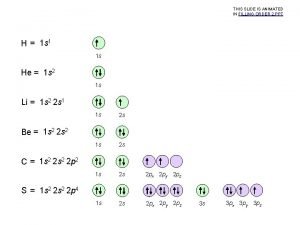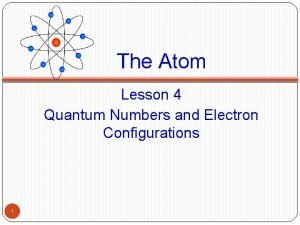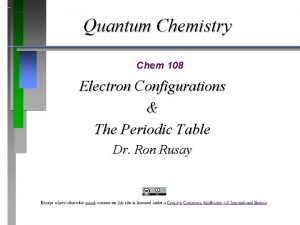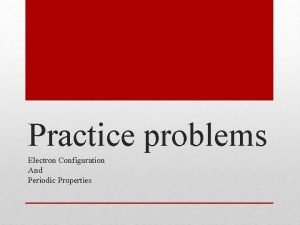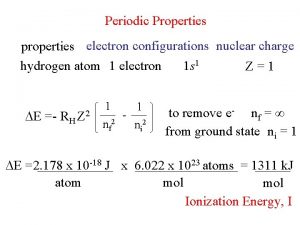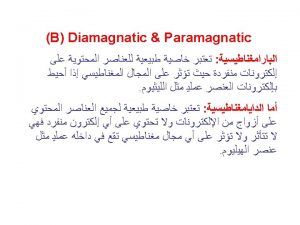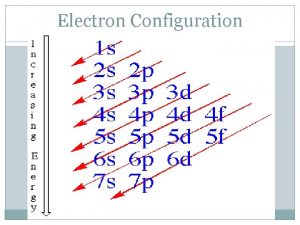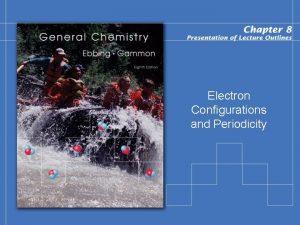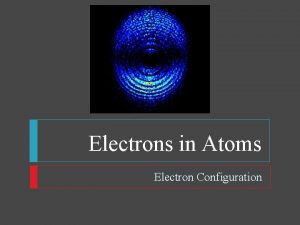ELECTRONIC CONFIGURATION Electron Configuration What do I mean












- Slides: 12

ELECTRONIC CONFIGURATION

Electron Configuration • What do I mean by “electron configuration? ” • The electron configuration is the specific way in which the atomic orbitals are filled. • Think of it as being similar to your address. The electron configuration tells me where all the electrons “live. ”




Rules for Electon Configurations https: //teach. lanecc. edu/gaudias/scheme. gif • In order to write an electron configuration, we need to know the RULES. • 3 rules govern electron configurations. – Aufbau Principle – Pauli Exclusion Principle – Hund’s Rule • Using the orbital filling diagram at the right will help you figure out HOW to write them – Start with the 1 s orbital. Fill each orbital completely and then go to the next one, until all of the elements have been acounted for.

Fill Lower Energy Orbitals FIRST http: //www. meta-synthesis. com/webbook/34_qn/qn 3. jpg • The Aufbau Principle states that electrons enter the lowest energy orbitals first. • The lower the principal quantum number (n) the lower the energy. • Within an energy level, s orbitals are the lowest energy, followed by p, d and then f. F orbitals are the highest energy for that level.

No more than 2 Electrons in Any Orbital…ever. http: //www. fnal. gov/pub/inquiring/timeline/images/pauli. jpg • The next rule is the Pauli Exclusion Principal. • The Pauli Exclusion Principle states that an atomic orbital may have up to 2 electrons and then it is full. • The spins have to be paired. • We usually represent this with an up arrow and a down arrow. • Since there is only 1 s orbital per energy level, only 2 electrons fill that orbital. Quantum numbers describe an electrons position, and no 2 electrons can have the exact same quantum numbers. Because of that, electrons must have opposite spins from each other in order to “share” the same orbital.

Hund’s Rule http: //intro. chem. okstate. edu/AP/2004 Norman/Chapter 7/Lec 111000. html Don’t pair up the 2 p electrons until all 3 orbitals are half full. • Hunds Rule states that when you get to degenerate orbitals, you fill them all half way first, and then you start pairing up the electrons. • What are degenerate orbitals? • Degenerate means they have the same energy. • So, the 3 p orbitals on each level are degenerate, because they all have the same energy. • Similarly, the d and f orbitals are degenerate too.

Electron Configurations Element Configuration H Z=1 1 s 1 He Z=2 1 s 2 Li Z=3 1 s 22 s 1 Be Z=4 1 s 22 s 2 B Z=5 1 s 22 p 1 C Z=6 1 s 22 p 2 N Z=7 1 s 22 p 3 O Z=8 1 s 22 p 4 F 1 s 22 p 5 Ne Z=10 1 s 22 p 6 (2 p is now full) Na Z=11 1 s 22 p 63 s 1 Cl Z=17 1 s 22 p 63 s 23 p 5 K 1 s 22 p 63 s 23 p 64 s 1 Sc Z=21 1 s 22 s 22 p 63 s 23 p 64 s 23 d 6 Br Z=35 Z=9 Z=19 Fe Z=26 1 s 22 p 63 s 23 p 64 s 23 d 104 p 5 Note that all the numbers in the electron configuration add up to the atomic number for that element. Ex: for Ne (Z=10), 2+2+6 = 10

Maximum Number of Electrons In Each Sublevel Number of Orbitals Maximum Number of Electrons s 1 2 p 3 6 d 5 10 f 7 14 Le. May Jr, Beall, Robblee, Brower, Chemistry Connections to Our Changing World , 1996, page 146

O Notation 15. 9994 • Aufbau’s Diagram / Orbital Diagram O 8 1 s 2 2 s 2 • Electron Configuration 2 2 4 1 s 2 s 2 p Courtesy Christy Johannesson www. nisd. net/communicationsarts/pages/chem 8 2 p 4
 Electron configuration vs noble gas configuration
Electron configuration vs noble gas configuration What does electron configuration mean
What does electron configuration mean Is the electronic exchange of money or scrip
Is the electronic exchange of money or scrip Electronic field production
Electronic field production Excited state electron configuration
Excited state electron configuration Orbital diagram for nickel
Orbital diagram for nickel Quantum numbers and electron configuration
Quantum numbers and electron configuration Oganesson electron configuration
Oganesson electron configuration Electron configuration practice problems
Electron configuration practice problems Electron configuration of c
Electron configuration of c Effective nuclear charge
Effective nuclear charge Paramagnetic unpaired electrons
Paramagnetic unpaired electrons Electron configuration of oxygen
Electron configuration of oxygen




